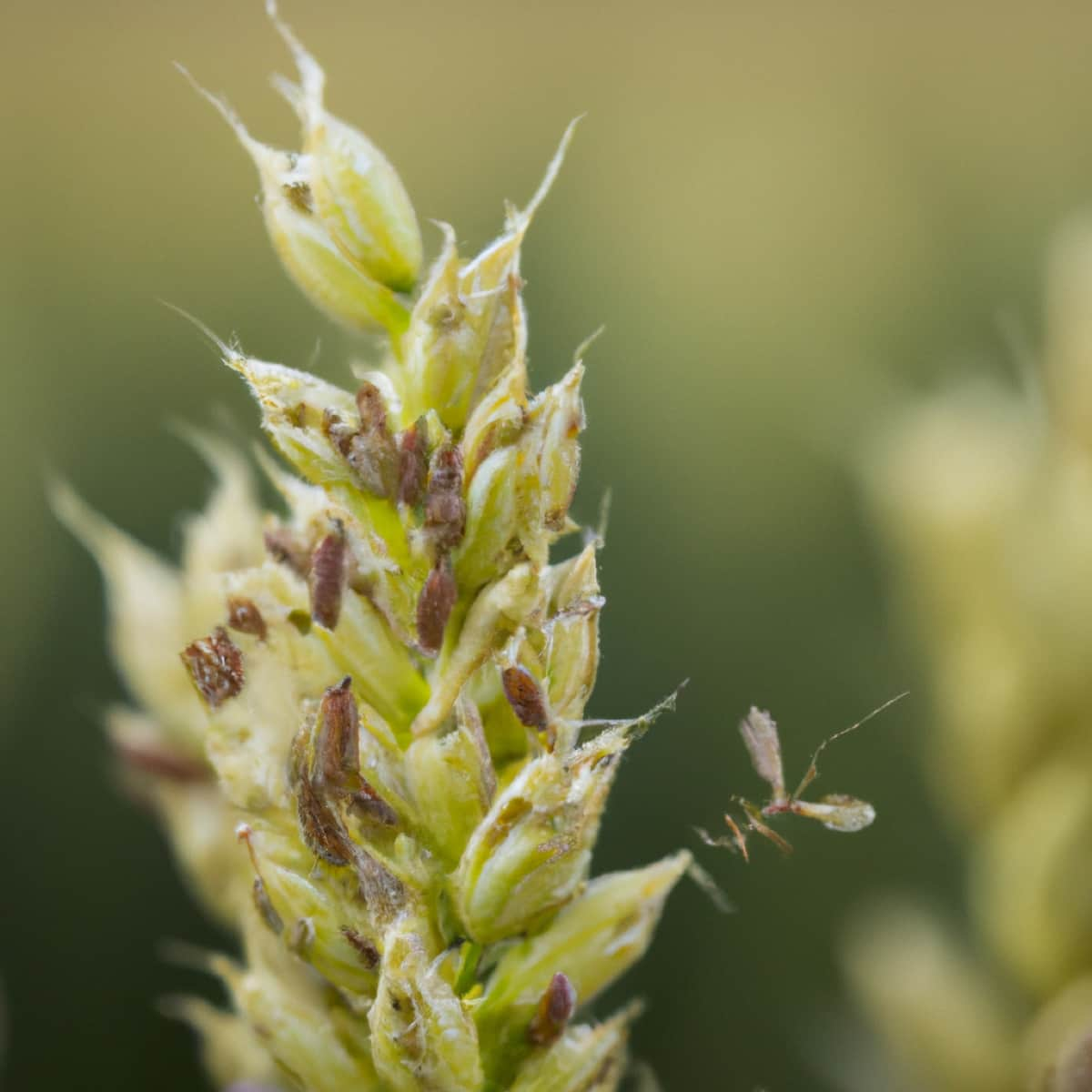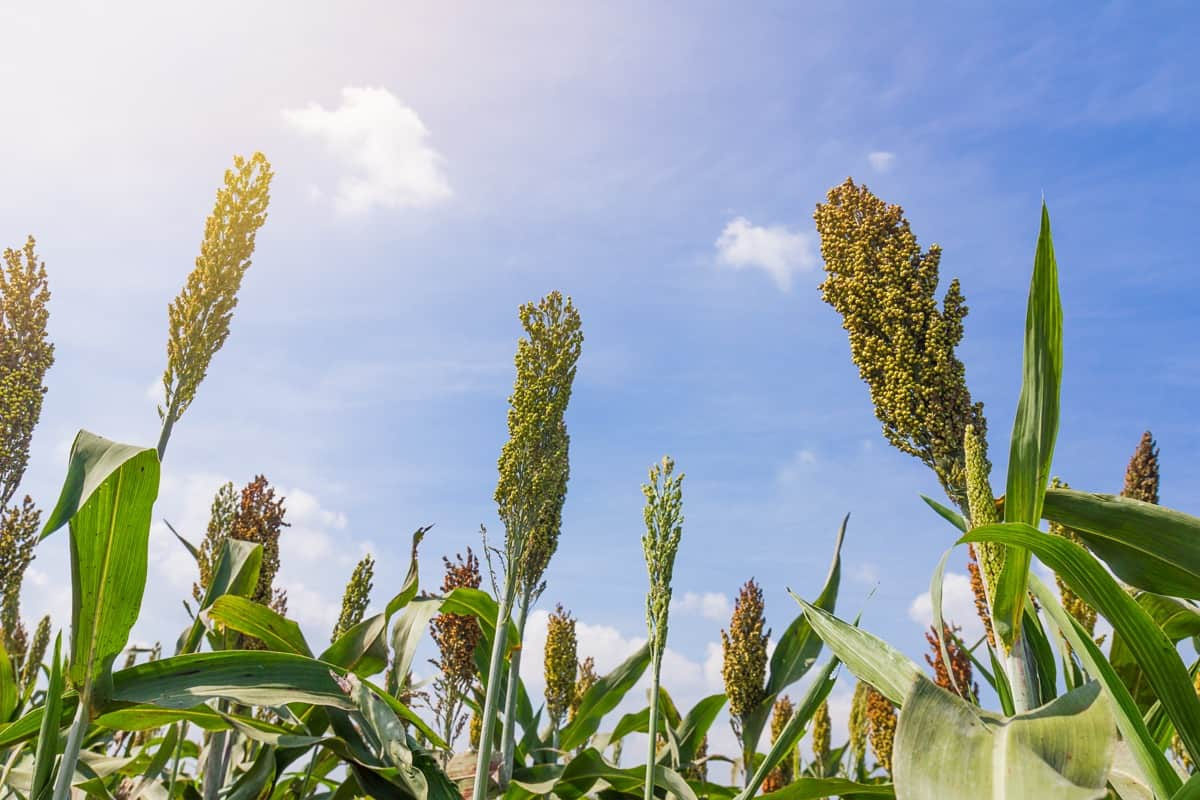Sorghum midge, Contarinia sorghicola, is a small fly belonging to the Family Cecidomyiidae of Order Diptera and is native to tropical and subtropical regions of the world. It feeds on developing panicles of Sorghum, robbing the plant of its ability to produce viable seeds. The presence of other pests like aphids, thrips, and beetles can further intensify the damage.

If the infestation is severe, the crop can be completely lost. To effectively manage this pest, it is important to understand its life cycle, its preferred habitats, and the best methods for controlling it. This article will provide an overview and discussion of the sorghum midge pest, including its symptoms, identification techniques, and control.
Sorghum Midge Management in Sorghum
Life Cycle of Sorghum Midge
The lifecycle comprises four stages: egg, larva, pupa, and adult. The female midge will lay its eggs on the stem, and the developing florets of sorghum plants’ inflorescence result in pollen dispersal at varying times. Adult females can lay 25-40 eggs at 7-11 pet florets. The incubation period for an egg is 3-4 days.
These eggs will now hatch into larvae known as maggots. The maggots feed on the pith of the stem, and its span is approximately 9-11 days comprising of 4 instars. The larval phase remains dormant in a cocoon between December to January in a spikelet. The duration of the pupal phase is 3-4 days. The adult arises from the pupa and feeds on nectar and pollen from flowers of sorghum plants.
The female midge lays eggs in the stems, beginning the cycle again. One lifecycle is completed in 15-17 days. So, each female can produce 10-12 generations. The sorghum midge pest is most damaging when it attacks young plants early in the vegetative phase. Sorghum midge infestation can also increase Sorghum’s susceptibility to other pests and diseases.
Occurrence of Sorghum Midge
- Location of Sorghum midge: The pest occurs in India, Pakistan, Bangladesh, Sri Lanka, Africa, South East Asia, China, West Indies, the USA, and Italy.
- Host range: The pest can cause an infestation in Sorghum’s cultivated and wild species.
Factors Favoring Population Increase in Sorghum Midge in Field
- Weather conditions: Warmer temperatures with higher relative humidity are the most favorable conditions for the development and reproduction of sorghum midge.
- Host plant availability: Sorghum midge attracts host plants with high sugar content, such as Sorghum. The sorghum midge population increases when host plant availability is high.
- High reproductive rate: The midge can produce several generations per season, leading to a rapid buildup of its population in a short amount of time. Additionally, the female midge can mate multiple times, resulting in an increased production of offspring.
- Lack of natural enemies: If no natural enemies are present, such as predators, parasitoids, and pathogens, the population of sorghum midge can increase.
- Poor Cultural control practices: Poor cultural control practices, such as crop rotation and timely destruction of crop residues, can increase the population of sorghum midge pests in sorghum crops.
- High-fertility soils: High-fertility soils, with ample nutrients and organic matter, can favor a higher population of sorghum midge pests in sorghum crops.
Identification of Sorghum Midge in the Sorghum field
- Egg: The eggs are very small, measuring about 0.04-0.05 mm in length, are either laid in solitary or bundles, and are white.
- Larva: The larval stage of the Sorghum Midge is the most destructive stage of its lifecycle. The larvae are white, spindle-shaped, and measure about 4 mm in length.
- Pupa: The pupal stage of the Sorghum Midge is the most protected stage of its lifecycle. The pupae are yellowish-brown and measure about 4-5 mm in length. They are found in the soil within the sorghum field.
- Adult: The adult stage of the Sorghum Midge is the most visible stage of its life cycle. The adults are brownish-grey in color and measure about 4 mm in length, and have a bright orange abdomen and a pair of transparent wings with a wingspan of about 3 mm.
In case you missed it: Ear Head Caterpillar Management in Sorghum: Symptoms, Treatment, Chemical, Biological, Natural, and Organic Control

Damage Symptoms of Sorghum Midge in Sorghum field
- These maggots will feed on the developing seeds and pupate there, leaving behind a web of silken threads, resulting in empty or hollowed grains, reduced grain size, and quality of the seeds. In addition to feeding on the panicles, the maggots release toxic saliva into the tissue of the plants, causing further damage.
- The seeds have white pupal shells that stick out from them and chaffy kernels with cavities.
- Dispersal of pollen grains due to eggs laid by the female midge.
- In mature crops, the sorghum panicles will exhibit a blasted appearance.
- In the grain filling or milk phase, if destroyed spikelets are squeezed using forceps, they will ooze out the larval and pupal contents of the midge in red.
Percentage of Yield Lose in Sorghum due to Sorghum Midge
Generally, In India, losses due to this pest can be as high as 50% in severe infestations. The losses are greater when the infestation is combined with other pests, such as aphids, thrips, and beetles.
Cultural Control of Sorghum Midge
- Resistant varieties – Use resistant varieties like ICSV 197, ICSV 745, ICSV 88032, DJ 6541, and AF 28.
- Crop rotation – Planting non-sorghum crops in between sorghum crop cycles helps break the pest’s life cycle and reduce its population.
- Sowing duration – Sorghum must be sown quickly to prevent constant blooming, which encourages the spread of grain midges.
- Sanitation – Removing crop debris from the field after harvest can help to reduce the number of places where the midge can lay its eggs.
- Light trap – Employ the use of a light trap till midnight to attract and kill the sorghum grain midge.
Biological Control of Sorghum Midge
- Larval parasitoids – Introduce the parasitoids that feed on the larval phase of insect pest Apanteles sp., Eupelones popa., Aprostocetus spp.
- Larval and Pupal parasitoids – Tetrastichus spp. is a parasitoid that feeds on both the larval and pupal phases of the midge.
- Predators – Orius albidipennis; Tapinoma indicum will suppress the adult population of the midge.
Chemical Control of Sorghum Midge
- Apply NSKE 5% (Neem Seed Kernel Extract) or apply malathion 50 EC @ 1-1.5 L/ha or endosulfan 35 EC @ 1 L or phosalone 1.15 L/ha or carbaryl 50 WP 2 kg/ha by spraying at almost 90% of panicle emergence and again after every 4-5 days.
- Apply Carbaryl 10 D or Malathion 5 D or Phosalone 4 D or Endosulfan 4D or quinalphos 1.5 D @ 25 kg/ha on the 3rd and 18th day after panicle emergence.
Preventive Measures for Control of Sorghum Midge
- Planting resistant varieties with strong antixenosis and antibiosis resistance can effectively reduce the damage caused by the pest.
- Planting sorghum seeds early in the season can reduce the damage caused by sorghum midge, as the pest is most active during the late season.
- Regular monitoring of the crop field and the surrounding environment is important to detect the presence of the pest and take necessary action.
- Natural predators like ladybird beetles, lacewings, etc., can be used to control the population of sorghum midge.
- Neem oil has been used to control several pests, including sorghum midge. A natural insecticide like neem oil can suppress the pest population.
In case you missed it: Rust Disease Management in Sorghum: Symptoms, Treatment, Chemical, Biological, Natural, and Organic Control

Conclusion
The conclusion drawn from the study of the sorghum midge pest is that it is a major pest of grain sorghum in Africa and the Middle East. It is capable of significantly reducing crop yields and causing economic losses in grain sorghum production. The most effective pest control is through biocontrol agents such as predators and parasitoids.
Chemical control agents, such as insecticides, can be used to reduce the pest population but must be used judiciously to avoid the development of resistance. More advanced research is needed to improve our understanding of pests and develop more effective and sustainable control methods.
- Deworming Schedule for Dogs/Puppies: A Beginners Guide
- How to Prevent and Control Parasites in Goats
- Beneficial Insects in Pest Management
- Natural Solutions for Pest Control in Flower Gardens
- Types of Fungicides Used in Agriculture
- Common Issues in the Fruit Development Stage of Pomegranate Farming
- Fruit Development Issues in Papaya: Easy Solutions and Treatment
- Soil-Borne Diseases and How to Protect Your Plants
- Practices to Prevent Disease Spread in the Garden